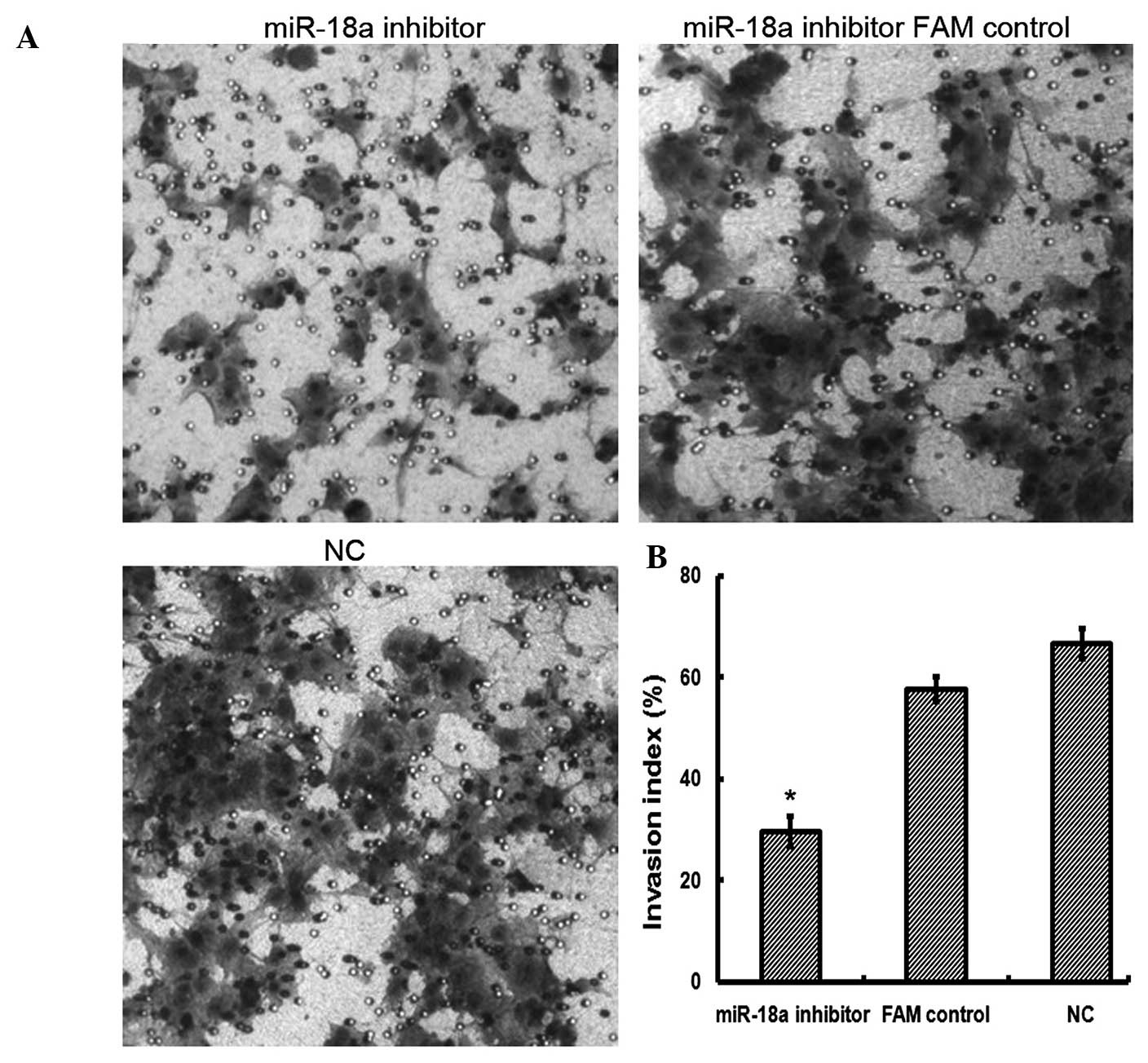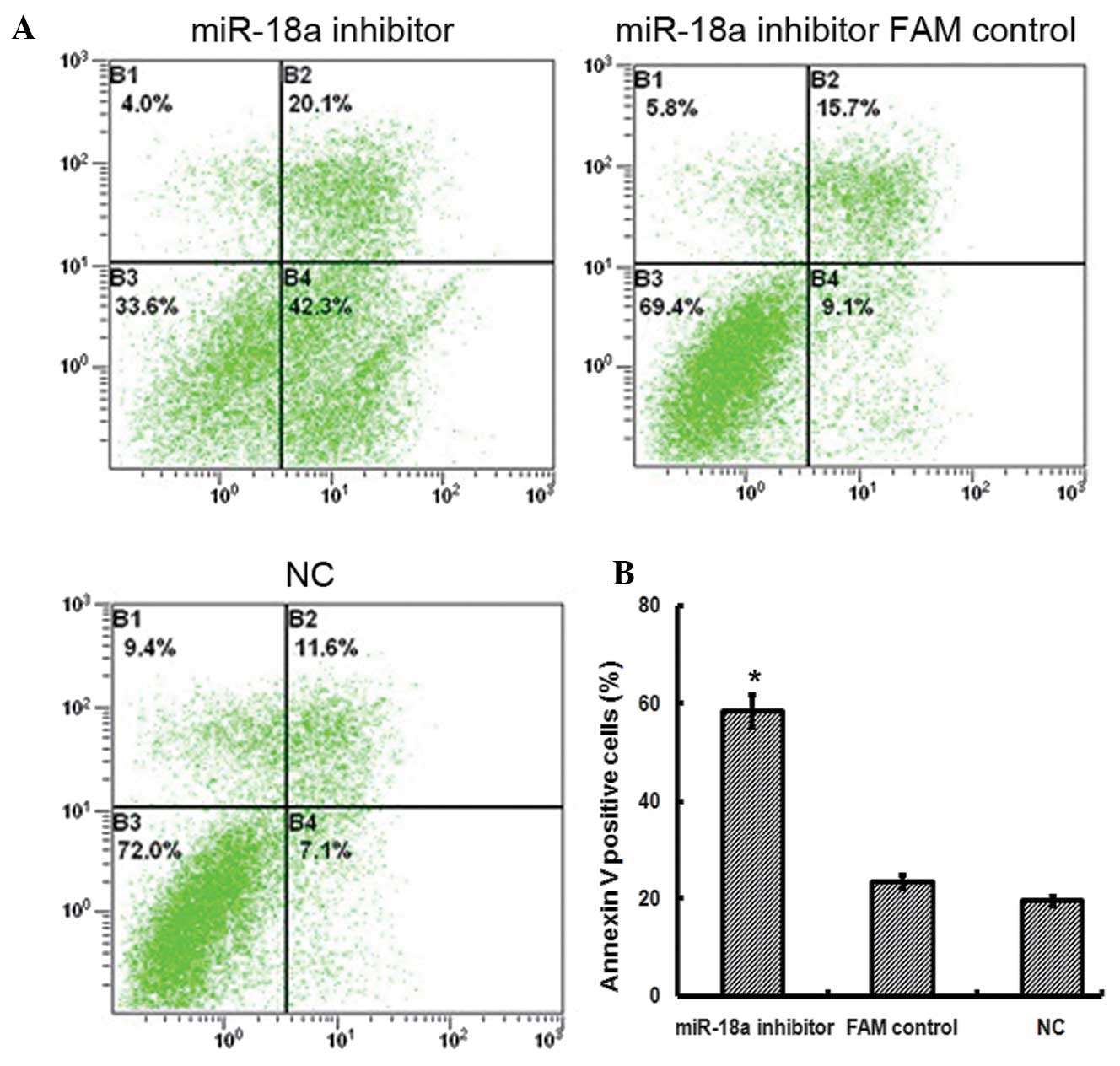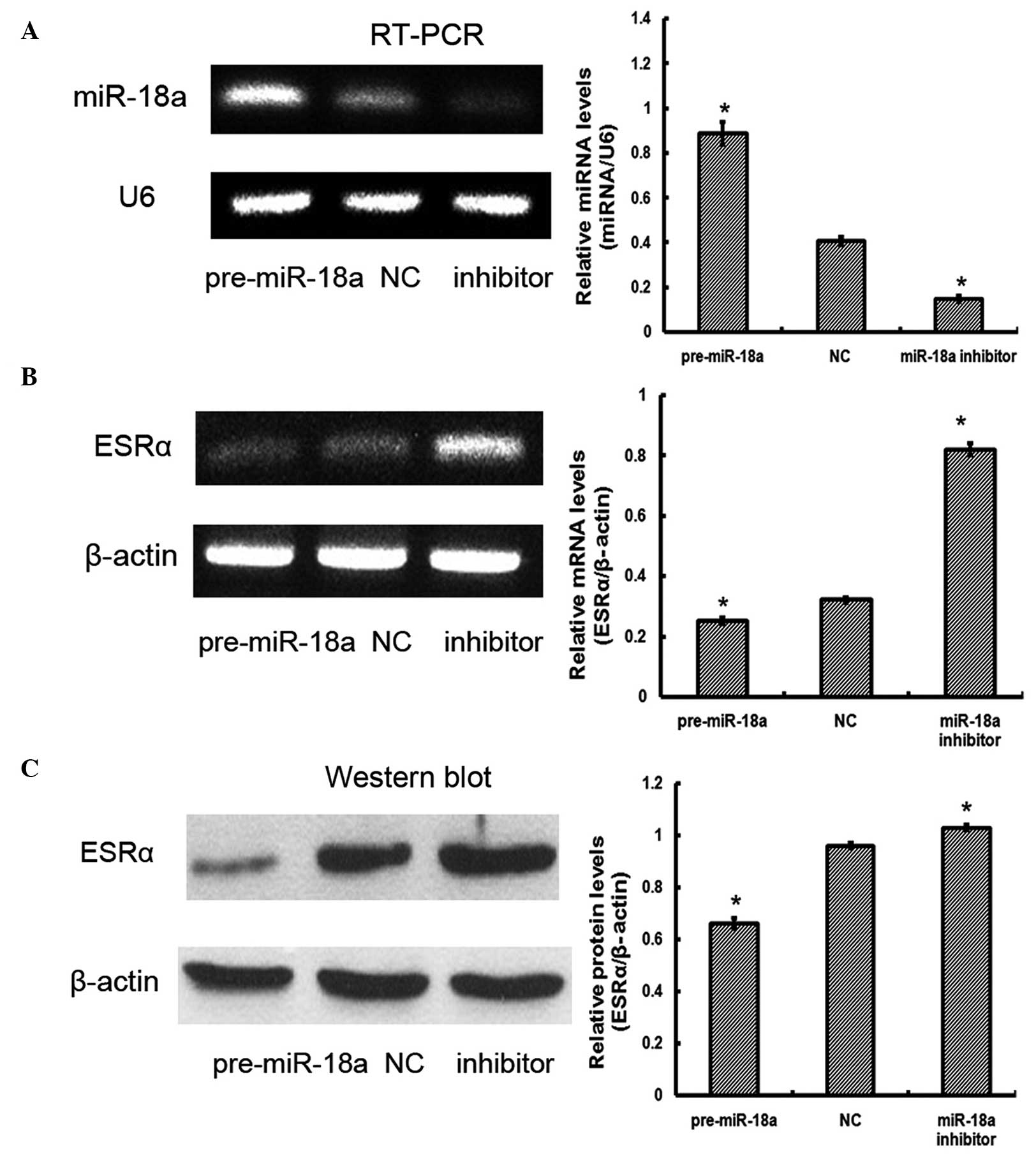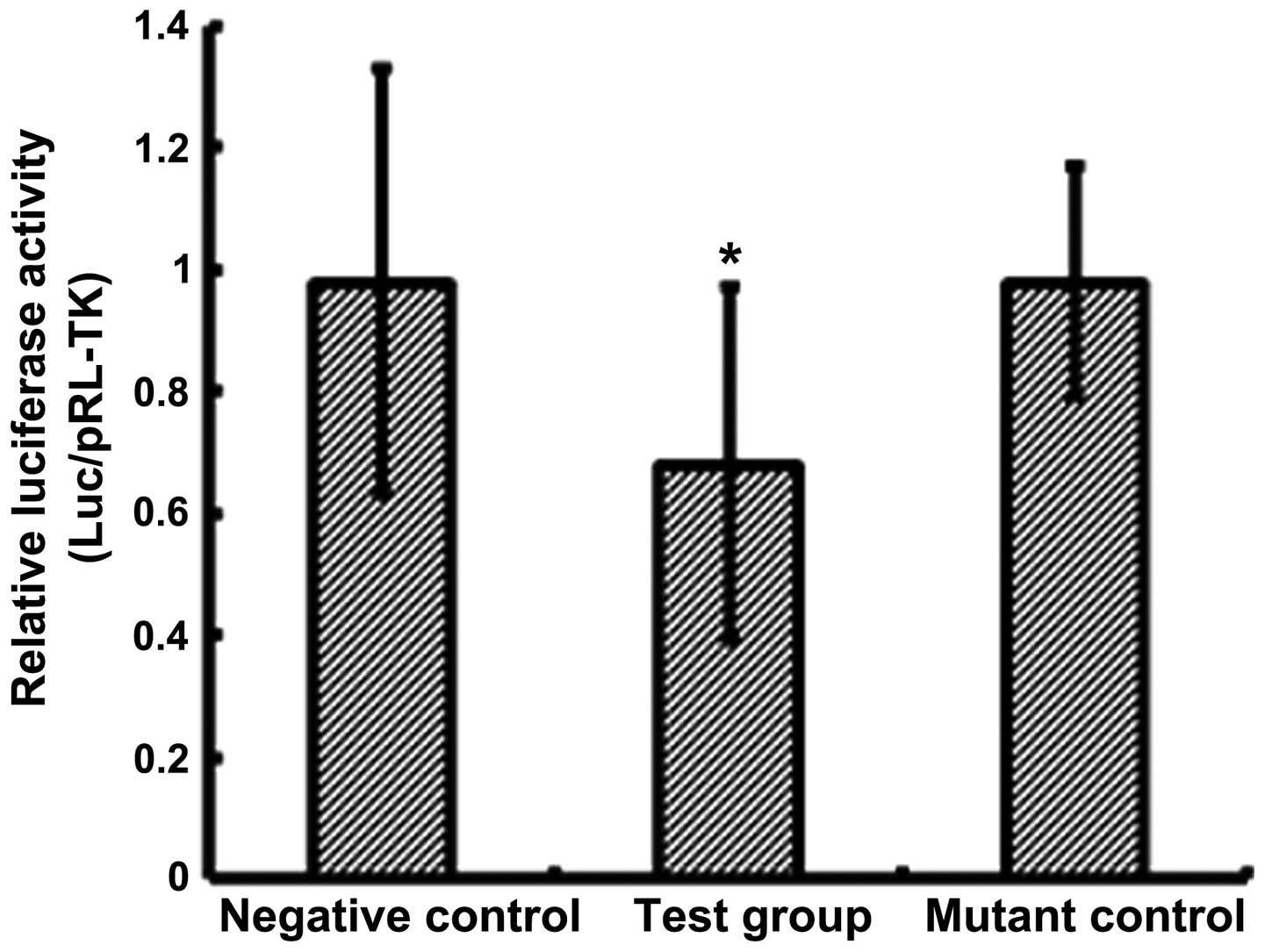Suppression of microRNA-18a expression inhibits invasion and promotes apoptosis of human trophoblast cells by targeting the estrogen receptor α gene
- Authors:
- Published online on: May 4, 2015 https://doi.org/10.3892/mmr.2015.3724
- Pages: 2701-2706
Abstract
Introduction
MicroRNAs (miRs) are a class of small (21–24 bp), noncoding RNAs, which are involved in the negative regulation of gene expression. miRs bind to complementary sequences in the 3′-untranslated region (3′-UTR) of their target mRNAs, causing destabilization of the transcript or inhibition of translation (1–3). miRs are involved in a number of biological and pathological processes, including cell proliferation, cell differentiation and carcinogenesis (4,5). Previous studies have suggested that miR expression is tissue-specific and that a number of miRs are expressed in the human placenta (6,7). A previous study demonstrated that miR-18a is downregulated in pre-eclamptic placentas (8). miR-18a is a component of the miR-17-92 gene cluster, which is located on chromosome 13q31.3. Evidence has suggested that miR-18a targets the estrogen receptor α-3′ (ESRα-3′) UTR in human hepatocellular carcinoma cells (9).
ESRs are ligand-activated transcription factors. They are members of the nuclear hormone receptor superfamily, which mediate the pleiotropic effects of the steroid hormone, estrogen via a range of developmental and physiological processes (10). There are two forms of ESR: ESRα and ESRβ, which are encoded by ESR1 and ESR2, respectively. ESRα is predominantly expressed in the ovaries, uterus and placenta (11), while ESRβ is expressed in a number of types of tissues (12). A previous study suggested that ESRα mRNA and protein levels were significantly increased in pre-eclamptic pregnancies compared with levels in healthy pregnancies (13).
Previous studies have demonstrated that miR-18a is under-expressed (8), and ESRα is overexpressed, in pre-eclamptic placentas (13). The results of previous studies have suggested that miR-18a may be involved in the pathogenesis of pre-eclamptic pregnancies via ESRα regulation. In order to gain further understanding of the association between miR-18a and ESRα in human trophoblast cells, the present study analyzed the effect of miR-18a on trophoblast invasion, cell apoptosis and ESRα expression in JEG-3 cells.
Materials and methods
Cell culture and transient transfection
JEG-3 human trophoblast choriocarcinoma cells were obtained from the American Type Culture Collection (ATCC, Manassas, VA, USA). JEG-3 cells were cultured in Dulbecco’s modified Eagle’s medium (DMEM; Gibco Life Technologies, Carlsbad, CA, USA), containing 10% fetal bovine serum (FBS; Gibco Life Technologies, Carlsbad, CA, USA). Cells were cultured at 37°C, in a humidified atmosphere at 5% CO2.
Pre-miR-18a mimics (pre-miR-18a), pre-miR negative control (NC), an miR-18a inhibitor and miR-18a inhibitor FAM-labeled controls were used to determine the transfection efficiency and were purchased from Jima (Beijing, China). JEG-3 cells were transfected with pre-miR-18a or miR-18a inhibitors using Lipofectamine 2000® (Gibco Life Technologies) according to the manufacturer’s instructions. The medium was replaced with fresh growth medium following 12 h of transfection. Following 48–72 h of transfection, a Transwell invasion assay was conducted.
Transwell invasion assay
Transfected cells were seeded at 4×105 cells/insert in Transwell inserts (8-μm pore size; Costar, Corning, Cambridge, MA, USA) pre-coated with BD matrigel matrix (BD Biosciences, USA), and they were incubated with DMEM medium, without FBS. Lower chambers were loaded with DMEM medium, containing 10% FBS.
Cells were incubated at 37°C for 24 h. Following incubation, invading cells were fixed with 95% ethanol and stained using crystal violet (Beyotime Institue of Biotechnology, Nanjing, China). Non-invading cells were removed with a cotton swab. The cell invasion index was determined by counting the number of stained cells in ten randomly selected non-overlapping fields of the membranes, using a light microscope (TE2000S; Nikon, Japan; magnification, x200).
Cell apoptosis assay via flow cytometry
Following transfection for 48 h, JEG-3 cell apoptosis was analyzed using flow cytometry. 5×105 treated cells/well were seeded into 24-well plates and were incubated with annexin V and propidium iodide (BD Biosciences, San Diego, CA, USA) for 15 min at room temperature, in darkness. Cells were then analyzed using a fluorescence activated cell sorting (FACS) flow cytometer (BD Biosciences). Experiments were repeated three times.
Reverse transcription-polymerase chain reaction (RT-PCR) analysis
Total RNA was isolated from JEG-3 cells using TRIzol® (Invitrogen Life Technologies, Carlsbad, CA, USA). RNA integrity was confirmed using electrophoresis in a 1.5% agarose denaturing gel (Sangon Biotech, Shanghai, China). In order to detect the presence of ESRα, 1 μg total RNA was reverse transcribed into cDNA and primed with oligonucleotides, using a RevertAid first-strand cDNA synthesis kit (Thermo Fisher Scientific Baltics, Vilnius, Lithuania). β-Actin was used as a positive control.
In order to detect the miR, 2 μg of total RNA was reverse transcribed into cDNA with a gene-specific RT primer, which is capable of folding into a stem-loop structure. The highly conserved and universally expressed small nuclear RNA, U6, was used as an endogenous control. Primer sequences and PCR conditions are provided in Table I. A 25-μl PCR master mix was prepared as follows: RT products (1 μl), dNTPs (200 μmol/l), MgCl2 (2 mmol/l), Taq DNA polymerase (1 IU)and primers (10 pmol).
Table IPrimer sequences and reaction conditions for reverse transcription-polymerase chain reaction. |
PCR amplification was verified within the exponential phase of PCR using preliminary experiments. PCR products were subjected to electrophoresis on agarose gels, and the relative densities of target genes, standardized against that of the control genes was analyzed, using Image-Pro Plus (version 6.0; Media Cybernetics, Inc., Rockville, MD, USA).
Western blot analysis
Infected cells were washed three times with ice-cold phosphate-buffered saline (PBS) and then lysed with 1X lysis buffer (Cell Signaling Technology, Inc., Danvers, MA, USA). The supernatant was collected following centrifugation at 12,000 × g for 10 min at 4°C and protein estimation was conducted using a Bradford assay (14). Protein (30 μg) per lane was separated using 10% SDS-polyacry1-amide gel electrophoresis and transferred onto a polyvinylidene fluoride membrane (Hybond; GE Healthcare, Chalfont, UK) via semidry electroblotting. The membrane was blocked in 5% non-fat milk in PBS with Tween-20® (PBST) for 1 h at room temperature, and incubated with rabbit antibodies against human ESRα (1:2,500; rabbit monolonal; cat. no. ab32063; Epitomics, Burlingame, CA, USA), in PBS at 4°C overnight.
The membrane was washed PBST and incubated with a horseradish peroxidase-conjugated secondary antibody (1:5,000; cat. no. cw0111; Kangwei, Beijing, China) for 1 h at room temperature. Expression signals were detected using the Enhanced Chemiluminescent Substrate (Pierce Biotechnology, Inc., Rockford, IL, USA). The membrane was stripped and reprobed with the rabbit-anti-human β-actin antibody (1:3,000; Abcam, Cambridge, UK), which was used as a positive control. ESRα expression was standardized against that of β-actin, which was determined using densi-tometric analysis (Image-Pro Plus 6.0; Media Cybernetics, Inc., Rockville, MD, USA).
Luciferase reporter assay
In order to perform a luciferase reporter assay, the 3′-UTR segment of ESRα, which contains the miR-18a binding site (NM_000125), was PCR amplified using the total RNA extracted from JEG-3 cells and the following primers for ESRα: Forward: 5′-CCTAGCTAGCCAATGACCCAGGTGAGCTGCTCG-3′ and reverse: 5′-CCTAGCTAGCCATTCAATTGTCTGATAAACAAGC-3′ (9). The reporter plasmid was cloned by inserting the 3′-UTR segment of ESRα into the XbaI site of a pGL3-Promoter vector (Promega Corporation, Madison, WI, USA), in order to generate pMIR-UTR. The mutant ESRα-3′-UTR fragment was generated using a QuickChange II Site-Directed Mutagenesis kit (Agilent Technologies, Inc., Santa Clara, CA, USA). Transfection was performed using a Lipofectamine 2000 reagent.
Transfections of JEG-3 cells were performed using pMIR-UTR and pre-miR-18a for the experimental group. For the negative control group, transfections were performed using pMIR-UTR and pre-miR-control. Transfections were performed with pMIR-UTR-mutant and pre-miR-18a, for the mutant control group. Following 48 h of transfection, cells were lysed and measured for luciferase activity using a luciferase assay system (Promega Corporation, Madison, WI, USA), according to the manufacturer’s instructions. Cells were also transfected with 50 ng pRL-TK vector as an internal standard.
Statistical analysis
Values are presented as the mean ± standard deviation of three individual experiments. Comparisons between groups were performed using one-way analysis of variance. In all cases P<0.05 was considered to indicate a statistically significant difference. Statistical analyses were performed using SPSS version 13.0 (SPSS, Inc., Chicago, IL, USA).
Results
Suppression of miR-18a expression inhibits JEG-3 cell invasion
A cell invasion assay was performed in order to investigate the effect of miR-18a on JEG-3 cell invasion. As shown in Fig. 1, the suppression of miR-18a significantly inhibited cell invasion in JEG-3 cells (29.67±3.06; P<0.05) compared with that in the NC and FAM control cells (66.67±3.06 and 57.67±2.52, respectively). The data suggested that suppression of miR-18a may inhibit the invasive capacity of JEG-3 cells.
Suppression of miR-18a leads to increased cell apoptosis in JEG-3 cells
A cell apoptosis assay was performed using flow cytometry, in order to investigate whether decreased miR-18a expression in JEG-3 cells was associated with a change in cell apoptosis. Following transfection with the miR-18a inhibitor, JEG-3 cell apoptosis was higher (58.63±3.27; P<0.05) than that in the control cells (NC, 19.50±0.92; FAM control, 23.30±1.37; Fig. 2). The results of the present study, therefore, suggested that the suppression of miR-18a expression may promote JEG-3 cell apoptosis.
Validation of ESRα as a target of miR-18a in JEG-3 cells
In order to assess whether miR-18a affects ESRα expression, the levels of ESRα mRNA and protein were measured in JEG-3 cells that had been transfected with pre-miR-18a or miR-18a inhibitor. RT-PCR analysis suggested that transfection was effective (Fig. 3A). Significant differences were observed in ESRα mRNA expression levels: Pre-miR-18a, 0.25±0.01; NC, 0.32±0.01; miR-18a inhibitor, 0.82±0.02; P<0.05 (Fig. 3B). Significant differences were also observed in ESRα protein expression levels: pre-miR-18a, 0.66±0.02; NC, 0.96±0.01; miR-18a inhibitor, 1.03±0.01; P<0.05 (Fig. 3C). The results of the present study indicated that miR-18a downregulated ESRα mRNA and protein expression in JEG-3 cells compared with that in control cells.
It has been shown that miRs modulate gene expression through association with the 3′-UTR region of target genes (1–3). A luciferase reporter assay was conducted, and a significant reduction (0.68±0.29; P<0.05) in luciferase activity was observed in pre-miR-18a-transfected cells, compared with cells in the control groups (NC, 0.98±0.35; mutant control, 0.98±0.19; Fig. 4). The results of the present study suggested that ESRα is involved in the regulation of miR-18a expression in JEG-3 cells.
Discussion
Suppression of miR-18a expression leads to decreased cell invasion and increased cell apoptosis in JEG-3 human trophoblast cells, by inducing ESRα expression. The results of the present study supported the findings of Liu et al (9), which demonstrated that miR-18a may suppress ESRα expression in human hepatocellular carcinoma cells.
The JEG-3 cell line is a well-established human trophoblast cell model that has been used in studies investigating failed pregnancies (15–17). In the present study, in vitro experiments were performed in order to determine the effect of miR-18a on JEG-3 cell invasion. The results suggested that the suppression of miR-18a expression may inhibit the invasive capacity of JEG-3 cells. Xu et al (18) demonstrated that overexpression of miR-18a may promote cell invasion in HTR8/SVneo human trophoblast cells by targeting Smad2 expression. Smad2 mediates TGF-β signaling, which is involved in regulating trophoblast cell invasion (19–21). Therefore, miR-18a may regulate trophoblast cell invasion via the TGF-β signaling pathways. Furthermore, different types of miRs may be involved in the regulation of a single gene (22). Therefore, it will useful to examine other targets of miR-18a in future studies.
The suppression of miR-18a expression led to an increase in JEG-3 cell apoptosis. The results of the present study suggested that miR-18a may function as an antiapoptotic factor in human trophoblast cells. Previous studies have demonstrated that miR-18a is downregulated (8), whilst ESRα expression is upregulated (13), in pre-eclamptic placentas, compared with levels in healthy placentas. The expression of miR-18a was negatively correlated with ESRα expression in pre-eclampsia, which suggests that miR-18a is involved in the pathogenesis of pre-eclampsia, via negative regulation of ESRα expression (8–13). Recent studies have shown that ESRα expression is involved in cell apoptosis (23), and that a change in cell apoptosis is associated with the pathogenesis of pre-eclampsia (24). Therefore, the low expression of miR-18a may affect trophoblast cell apoptosis by regulating ESRα expression, which may contribute to pre-eclampsia. Further investigation is therefore required, in order to clarify the involvement of miR-18a in pre-eclamptic pregnancies.
The results of the present study demonstrated that miR-18a suppressed ESRα expression by targeting its 3′-UTR binding sites. However, ESRα expression was not completely inhibited in response to miR-18a overexpression (Fig. 4). miR-18a gene overexpression led to a decrease in luciferase reporter gene expression by ~30% (Fig. 4), which suggests that additional miRs may participate in the regulation of ESRα expression. Studies have demonstrated that a single gene may be regulated by a number of different miRs (1–3,22). Therefore, further studies are required, in order to investigate the involvement of other miRs in the regulation of ESRα expression.
In conclusion, the present study demonstrated that miR-18a expression suppresses ESRα expression by targeting binding sites in the 3′-UTR. The suppression of miR-18a led to a decrease in invasion and an increase in the apoptosis of JEG-3 cells. The present study, therefore, provides evidence for the involvement of miR-18a in the pathogenesis of pre-eclampsia.
Acknowledgments
This study was supported by the Chinese Natural Science Foundation (grant nos. 81471474/31000660 and 81170582), the Postdoctoral Science Foundation of China (grant nos. 2014T70964 and 2013M532203), and Tangdu Hospital Reserve Personnel Fund.
References
|
Zeng Y: Principles of micro-RNA production and maturation. Oncogene. 25:6156–62. 2006. View Article : Google Scholar : PubMed/NCBI | |
|
Lai EC: microRNAs: runts of the genome assert themselves. Curr Biol. 13:R925–R936. 2003. View Article : Google Scholar : PubMed/NCBI | |
|
Ke XS, Liu CM, Liu DP and Liang CC: MicroRNAs: key participants in gene regulatory networks. Curr Opin Chem Biol. 7:516–23. 2003. View Article : Google Scholar : PubMed/NCBI | |
|
Bushati N and Cohen SM: microRNA functions. Annu Rev Cell Dev Biol. 23:175–205. 2007. View Article : Google Scholar : PubMed/NCBI | |
|
Sun BK and Tsao H: Small RNAs in development and disease. J Am Acad Dermatol. 59:725–737. 2008. View Article : Google Scholar | |
|
Barad O, Meiri E, Avniel A, Aharonov R, Barzilai A, Bentwich I, Einav U, Gilad S, Hurban P, Karov Y, et al: MicroRNA expression detected by oligonucleotide microarrays: system establishment and expression profiling in human tissues. Genome Res. 14:2486–2494. 2004. View Article : Google Scholar : PubMed/NCBI | |
|
Lim LP, Lau NC, Garrett-Engele P, Grimson A, Schelter JM, Castle J, Bartel DP, Linsley PS and Johnson JM: Microarray analysis shows that some microRNAs downregulate large numbers of target mRNAs. Nature. 433:769–773. 2005. View Article : Google Scholar : PubMed/NCBI | |
|
Zhu XM, Han T, Sargent IL, Yin GW and Yao YQ: Differential expression profile of microRNAs in human placentas from preeclamptic pregnancies vs normal pregnancies. Am J Obstet Gynecol. 200:661.e1–e7. 2009. View Article : Google Scholar | |
|
Liu WH, Yeh SH, Lu CC, Yu SL, Chen HY, Lin CY, Chen DS and Chen J: MicroRNA-18a prevents estrogen receptor-alpha expression, promoting proliferation of hepatocellular carcinoma cells. Gastroenterology. 136(2): 683–693. 2009. View Article : Google Scholar | |
|
Shao W and Brown M: Advances in estrogen receptor biology: prospects for improvements in targeted breast cancer therapy. Breast Cancer Res. 6:39–52. 2004. View Article : Google Scholar : | |
|
Kuiper GG, Carlsson B, Grandien K, Enmark E, Häggblad J, Nilsson S and Gustafsson JA: Comparison of the ligand binding specificity and transcript tissue distribution of estrogen receptors alpha and beta. Endocrinology. 138:863–870. 1997.PubMed/NCBI | |
|
Kuiper GG, Enmark E, Pelto-Huikko M, Nilsson S and Gustafsson JA: Cloning of a novel receptor expressed in rat prostate and ovary. Proc Natl Acad Sci USA. 93:5925–5930. 1996. View Article : Google Scholar : PubMed/NCBI | |
|
Yin G, Zhu X, Guo C, Yang Y, Han T, Chen L, Yin W, Gao P, Zhang H, Geng J, et al: Differential expression of estradiol and estrogen receptor α in severe preeclamptic pregnancies compared with normal pregnancies. Mol Med Rep. 7:981–985. 2013.PubMed/NCBI | |
|
Bradford MM: A rapid and sensitive method for the quantitation of microgram quantities of protein utilizing the principle ofproteindye binding. Anal Biochem. 72:248–254. 1976. View Article : Google Scholar : PubMed/NCBI | |
|
Kilburn BA, Wang J, Duniec-Dmuchowski ZM, Leach RE, Romero R and Armant DR: Extracellular matrix composition and hypoxia regulate the expression of HLA-G and integrins in a human trophoblast cell line. Biol Reprod. 62:739–747. 2000. View Article : Google Scholar : PubMed/NCBI | |
|
Mouillot G, Marcou C, Zidi I, Guillard C, Sangrouber D, Carosella ED and Moreau P: Hypoxia modulates HLA-G gene expression in tumor cells. Hum Immunol. 68:277–285. 2007. View Article : Google Scholar : PubMed/NCBI | |
|
Yie SM, Li LH, Li GM, Xiao R and Librach CL: Progesterone enhances HLA-G gene expression in JEG-3 choriocarcinoma cells and human cytotrophoblasts in vitro. Hum Reprod. 21:46–51. 2006. View Article : Google Scholar | |
|
Xu P, Zhao Y, Liu M, Wang Y, Wang H, Li YX, Zhu X, Yao Y, Wang H, Qiao J, et al: Variations of microRNAs in human placentas and plasma from preeclamptic pregnancy. Hypertension. 63:1276–1284. 2014. View Article : Google Scholar : PubMed/NCBI | |
|
Irving JA and Lala PK: Functional role of cell surface integrins on human trophoblast cell migration: regulation by TGF-beta, IGF-II, and IGFBP-1. Exp Cell Res. 217:419–427. 1995. View Article : Google Scholar : PubMed/NCBI | |
|
Morrish DW, Dakour J and Li H: Functional regulation of human trophoblast differentiation. J Reprod Immunol. 39:179–195. 1998. View Article : Google Scholar : PubMed/NCBI | |
|
Caniggia I, Grisaru-Gravnosky S, Kuliszewsky M, Post M and Lye SJ: Inhibition of TGF-beta 3 restores the invasive capability of extravillous trophoblasts in preeclamptic pregnancies. J Clin Invest. 103:1641–1650. 1999. View Article : Google Scholar : PubMed/NCBI | |
|
Jackson RJ and Standart N: How do microRNAs regulate gene expression? Sci STKE. 2007:re12007. View Article : Google Scholar : PubMed/NCBI | |
|
Chen P, Wang H, Duan Z, Zou JX, Chen H, He W and Wang J: Estrogen-related receptor alpha confers methotrexate resistance via attenuation of reactive oxygen species production and P53 mediated apoptosis in osteosarcoma cells. Biomed Res Int. 2014:6160252014. View Article : Google Scholar : PubMed/NCBI | |
|
Levy R: The role of apoptosis in preeclampsia. Isr Med Assoc J. 7:178–181. 2005.PubMed/NCBI |













